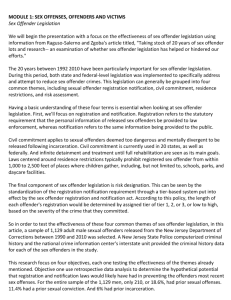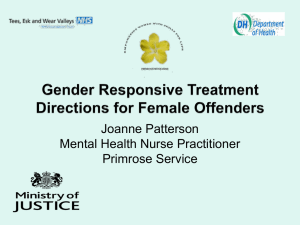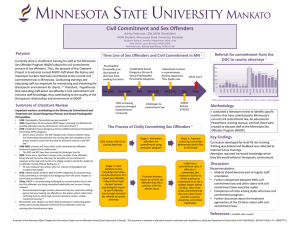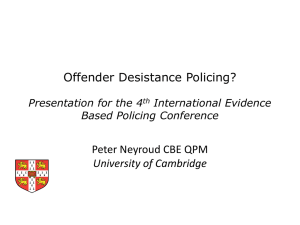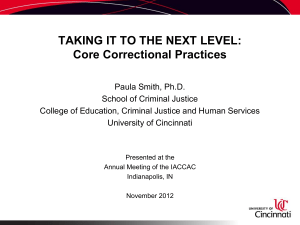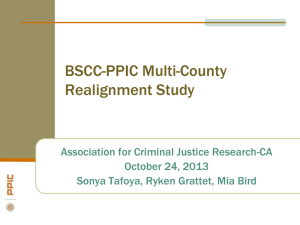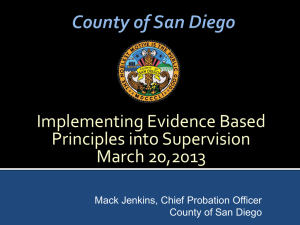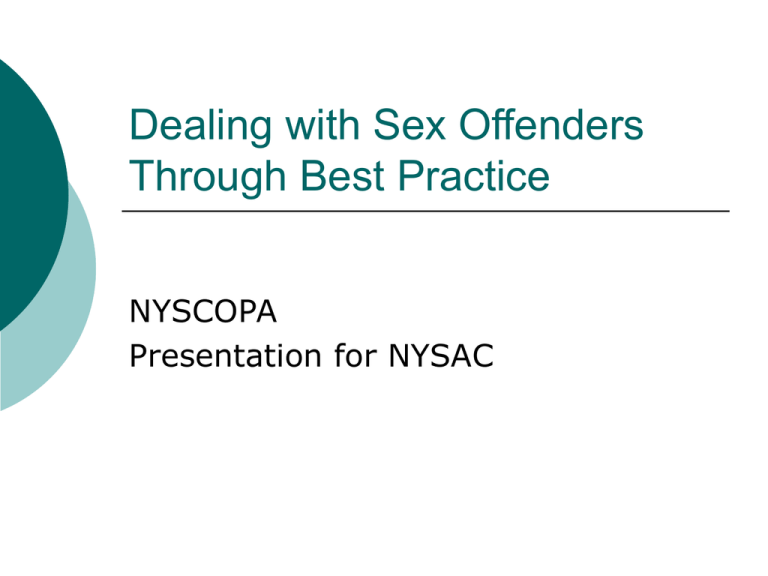
Dealing with Sex Offenders
Through Best Practice
NYSCOPA
Presentation for NYSAC
Presenters
Barbara Mentry, Oswego County
Mary Ellen Still, Dutchess County
William Connors, Albany County
Rocco Pozzi, Westchester County
Francine Perretta, St. Lawrence
County
Overview of Best Practice
Assessment and Treatment
Supervision
Global Positioning
Public Education
Not All Sex Offenders Are The Same
Dentist convicted of sexual
assaults against female
patients
Prison guard
forced female
inmates to have
sex
Juvenile
named as
Westside serial
rapist
Mayor jailed on child
pornography charges
Assessment and Treatment
Mary Ellen Still
Director
Dutchess County Probation and
Correctional Alternatives
Supervision
William Connors
Principle Probation officer
Albany County Probation
Global Positioning Services
Rocco Pozzi
Commissioner
Westchester County Probation
Public Education
Francine Perretta
Director
St. Lawrence County Probation
Few of us would question the need for
sex offenders to be held accountable for
their actions. Yet while holding them
accountable, we must insure that sex
offender registration and community
notification is not used as additional
punishment. It is, and is meant to be,
regulatory.”
Fair, responsible, and non-inflammatory
community notification is a reasonable
consequence to the acts of the offender;
furthermore, it allows citizens to take
prudent and rational steps to protect
themselves, their children, and their
community from the sex offenders they
know about as well as those they don’t.”
“The
key component of
effective community
notification is community
education.”
SLC’s Public Education Learning
Objectives
Help Communities understand
“managing” sex offenders.
Inform communities about what
works and what’s effective.
Discuss the potential roles of
community members.
Community Notification
Balancing Act
Public right to know
Offenders right to be free from
vigilantism
It is not additional punishment
It
is regulatory
Community Notification
Notification: “The law is tailored to
help the community protect itself
from sexual predators under the
guidance of law enforcement, not to
punish sex offenders.”
9th Circuit Court of Appeals
Russell v. Gregoire 124 F.3d 1079
SLC Notification Form
“Sex offenders have always lived in our
communities; but it wasn’t until passage
of the Community Protection Act of 1990
that law enforcement even knew where
they were living. In many cases, law
enforcement is now able to share that
information with you. Citizen abuse of
this information to threaten, intimidate or
harass registered sex offenders will not be
tolerated.
Notification Form Continued
Such abuse could potentially end law
enforcement's ability to do
community notifications. We
believe the only person who wins if
community notification ends is the
sex offender, since sex offenders
derive their power through secrecy”.
Public Education Campaign
Billboards
Radio Spots
Newspaper coverage
Website: NoMoreVictimNY.com
Public Education Forums in all
localities
Collaboration with all agencies
Some myths and facts about residency restrictions
for sex offenders and recidivism:
Research shows that there is no
correlation between residency
restrictions and reducing sex offenses
against children or improving the
safety of children.
In fact, these ordinances may make our
children MORE vulnerable to sexual
predators.
Some myths and facts about residency
restrictions for sex offenders and recidivism:
Research does not support the belief
that children are more likely to be
victimized by strangers at the covered
locations than at other locations. In
fact, children are at greater risk of
sexual abuse from adults they know:
In 74% of sex offenses, the victims not only
knew their perpetrators, but knew them well.
The most frequent locations in which sexual
abuse occurs is in the victim’s home (30.5%),
in the victim’s neighborhood (23.8%) or in the
victim’s school (15.4%).
Some myths and facts about residency
restrictions for sex offenders and recidivism:
Sex offender recidivism, contrary
to what many people think, is
very low.
In fact, sex offenders have among the
LOWEST reported recidivism rates of all
offender groups.
A national Department of Justice study
conducted by Langan, et. al. in 2003
reported that only 5% of sex offenders
were rearrested and 3% reconvicted for
sex offenses within 3 years of release.
Some myths and facts about residency
restrictions for sex offenders and recidivism:
Residency restrictions may have the
unintended effect of INCREASING, not
decreasing risk and make supervision
and management more difficult.
We are safe when we know where sex
offenders are living and can supervise
them closely. We are at increased risk
when sex offenders are homeless or at
unknown addresses as a result of being
forced from their homes, to live away
from their families, or restricted from
living in geographic areas that are also
close to jobs, services, and treatment.
Other Considerations
Perception that chasing the offender
out of town makes the community
safer
Who’s town do we chase them to?
Isn’t a victim in New York the same
as a victim in California, Washington,
Oregon, Vermont, Ohio, etc?
Other Considerations
Chasing them from location to location
is a dangerous game
It is NOT in the best interest of the
community
Increases offender risk
Increases potential for vigilantism
It is NOT in the best interest of the offender
Severely impacts offender accountability
Doesn’t get the offender the help they
need
“The whirlwind”
Other Considerations
It is not in the best interest of
law enforcement
Severely
impacts law
enforcement’s ability to keep
track of the offender
Creates more work for us doing
failure to register cases
Fosters chaos
Collaboration
Rigorous community management
of convicted sex offenders is vital
to victim and public safety
Community management teams
should include:
Law enforcement
Victim advocates
Probation and parole
Department of Corrections
Treatment providers
You can take a leadership role in
protecting your community by
doing “effective” community
notification…
or
You can be part of the
problem and help community
notification go awry.
Remember knowing
where the offender lives
makes us much safer
than if they are in hiding
QUESTIONS

